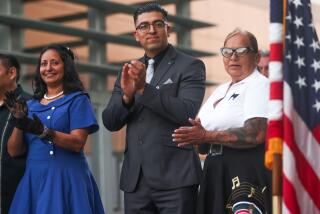Jean Drapeau; Praised and Scorned as Montreal’s Longtime Mayor
- Share via
Jean Drapeau, who served as mayor of Montreal in four decades and brought the city acclaim as host of a world’s fair in 1967 and severe criticism as host of the Summer Olympics in 1976, has died.
The 83-year-old Drapeau had been in poor health after suffering a stroke some years ago. He died Thursday in a Montreal hospital to which he was admitted July 5. The cause of death was not announced.
To the people of Montreal, Drapeau was “Mr. Mayor,” even after he left City Hall in 1986. After taking office in 1954, he spent 29 of the next 32 years in the mayor’s chair.
Pierre Bourque, the current mayor of Montreal, said Drapeau had a lasting impact on the city.
“Drapeau was a reformer,” he said. “When he was mayor, parts of Montreal were very poor. . . . He brought Montreal into the modern age.”
Drapeau changed Montreal but with a style of governance many viewed as autocratic. For most of his tenure, the City Council was merely a body that rubber-stamped his decisions. As one reporter who covered Montreal recalled, the only city plan for Montreal was the one that Drapeau kept in his head.
He improved the quality of life with major projects such as a subway system, called the Metro, that is viewed by many as the finest in the world--and in small ways, such as planting trees and creating parks and opening swimming pools.
In 1967 he brought a world’s fair--Expo 67--to Montreal that was a major success with 50,306,648 admissions, which set a record for single-season attendance. The fair did much for the prestige of Canada around the world.
Based on the success of Expo 67, Montreal was awarded a major league baseball team two years later and called it the Expos.
And finally, Drapeau brought the Olympics.
Before the Games, Drapeau joked that they could no more run into debt “than a man could have a baby.” But the baby the Olympics left the city was a $1-billion debt, which is still being paid off. The centerpiece of the cost overrun was one extravagant project: the Olympic Stadium.
Drapeau envisioned a stadium with a retractable roof. He found an architect to build his vision and gave him the commission without competitive bidding. Drapeau originally projected the cost for the facility at $120 million. By the early 1990s, when a 55-ton chunk of concrete fell from the stadium’s outer wall, forcing the Montreal Expos to find another place to play its games, the bill for construction and repair was a staggering $2 billion.
The retractable roof was not added to the facility until 1987, a full 12 years after the Olympic Games, and was not operative for another two years. After that the roof began to rip and has deteriorated to the point that it is no longer used. The stadium has fallen into disrepair and is perceived to be a tomb, unattractive to fans. Plans are being considered for a baseball stadium solely for the Expos.
There were other spending problems as well, such as the costly Olympic Village to house the athletes.
The cost overruns for the Games had an impact on the Olympic movement. Interest in hosting the 1984 games, the next Olympics up for bidding, was tepid at best .
The next year, the International Olympic Committee announced that Los Angeles was the only bidder for the Games. It marked the first time in the modern Olympic movement that there was no competition to stage the Games.
And there was concern among many that if Los Angeles did not turn a profit, there would be no bidders for future Olympic Games.
The organizers of the Los Angeles Games knew the stakes and held the line against extravagance. Instead of building costly facilities as Drapeau had done in Montreal, the L.A. organizers made do with what was available.
The result was an Olympic Games that made a profit of $222.7 million and became the business model for future large-scale athletic endeavors. Today, 15 years after the Games, interest income from that money is still used to support athletic programs for youngsters throughout the Southland. In Montreal, the debt from Drapeau’s Olympics is now just being paid off nearly 25 years later.
Drapeau, a stocky, rotund man, once said that for politicians there was one unforgivable sin: banality. A colorful figure, Drapeau avoided banality at all costs.
For part of his tenure, Drapeau’s popularity was enormous. In the 1966 mayoral election, which came just after the opening of the Metro, Drapeau received 97% of the popular vote.
He was born in a suburb of Montreal and grew up in a traditional French Canadian household that was averse to English. He graduated from the University of Montreal with a law degree. His start in politics came during World War II when he joined the League of Defense of Canada, a Quebec extremist group violently opposed to the federal government’s wartime conscription program. In the 1940s he ran for parliament and lost. He continued to practice law, defending striking asbestos workers in a celebrated case in 1949.
He was first elected mayor in 1954, but was ousted in the 1957 elections. Three years later he was again elected mayor and stayed in that position until 1986. After leaving office, he served as Canada’s ambassador to the United Nations from 1987 to 1991 before returning to Montreal and retirement.
In 1993, he underwent a triple-bypass heart operation. In 1997, he was hospitalized after breaking his hip.
He leaves a wife of 54 years, Marie-Claire, and his three sons, Francois, Pierre and Michel.
More to Read
Go beyond the scoreboard
Get the latest on L.A.'s teams in the daily Sports Report newsletter.
You may occasionally receive promotional content from the Los Angeles Times.






